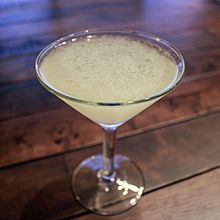Daiquiri facts for kids
| IBA official cocktail | |
|---|---|

Classic Daiquiri served in a cocktail glass
|
|
| Type | Cocktail |
| Primary alcohol by volume | |
| Served | Straight up; without ice |
| Standard drinkware | Cocktail glass |
| IBA specified ingredients |
|
| Preparation | In a cocktail shaker add all ingredients. Stir well to dissolve the sugar. Add ice and shake. Strain into chilled cocktail glass. |
| Timing | Happy Hour / Summer drink |
A daiquiri is a popular mixed drink. It's made with just a few main ingredients: rum, a type of citrus juice (usually lime juice), and sugar or something sweet. It's known as a type of cocktail.
The daiquiri is one of the "six basic drinks" mentioned in a famous book called The Fine Art of Mixing Drinks by David A. Embury. This book also shares different ways to make a daiquiri.
Where the Daiquiri Came From
The name Daiquirí comes from a beach and an iron mine located near Santiago de Cuba in Cuba. The word itself is from the Taíno language, spoken by the native people of the Caribbean.
The drink was supposedly invented by an American mining engineer named Jennings Cox. He was working in Cuba around the time of the Spanish–American War. Another idea is that William A. Chanler, a US congressman who bought the iron mines in 1902, might have introduced the daiquiri to clubs in New York that same year.
At first, the daiquiri was served in a tall glass filled with crushed ice. Sugar, lime juice, and white rum were added. The drink was then stirred with a long spoon. Later, people started mixing the daiquiri in a cocktail shaker with shaved ice. After shaking it well, they would pour it into a chilled coupe glass.
The daiquiri stayed mostly in Cuba until 1909. That's when Lucius W. Johnson, a doctor in the U.S. Navy, tried the drink. He liked it so much that he brought it back to the Army and Navy Club in Washington, D.C.. From there, the daiquiri became more and more popular over the years. Famous people like the writer Ernest Hemingway and U.S. President John F. Kennedy enjoyed it.
The drink became very popular in the 1940s. During World War II, it was hard to get drinks like whiskey and vodka. But rum was easy to find because of U.S. President Franklin D. Roosevelt's Good Neighbor policy. This policy helped improve trade and travel with countries in Latin America, including Cuba and the Caribbean. Because of this, rum-based drinks, which were once not as popular, became very fashionable in the US.
The basic recipe for a daiquiri is also similar to a drink called grog. British sailors drank grog from the 1780s to help prevent scurvy, a sickness caused by not getting enough Vitamin C. By 1795, the Royal Navy's daily grog included rum, water, lemon or lime juice, and sugar. This was a common drink across the Caribbean. When ice became available, it was added instead of water.
Different Kinds of Daiquiris
There are many ways to make a daiquiri! Here are a few popular ones:
- Hemingway daiquiri (also called papa doble): This version uses more white rum, juice from two limes, half a grapefruit, and a few drops of maraschino liqueur. It doesn't have added sugar.
- Banana daiquiri: This is a regular daiquiri with half a banana blended in.
Frozen Daiquiris
Many mixed drinks made with very finely crushed ice are called frozen daiquiris. These drinks can be made in a blender, which makes them smooth like a smoothie. Large machines are often used to make these drinks in different flavors, sometimes with different types of alcohol. Another way to make a frozen daiquiri, especially fruit-flavored ones, is by using frozen limeade. This gives the drink the right texture, sweetness, and sourness all at once.
Some popular frozen daiquiri variations include:
- Strawberry daiquiri: This is a blended drink made with puréed whole strawberries, rum, cane sugar, and lime juice.
- Old Rose Daiquiri: This uses strawberry syrup and rum, along with two teaspoons of sugar and lime juice.
- Mulata Daiquiri: This mixes rum with either coffee or chocolate liqueur, fresh lime juice, and sugar syrup.
See also
 In Spanish: Daiquirí para niños
In Spanish: Daiquirí para niños


